Overview
Direct Query in Power BI represents a transformative connectivity mode, enabling users to access real-time data directly from the source without the need for importing. This capability significantly enhances operational efficiency and empowers timely decision-making.
Notably, this approach facilitates immediate insights and minimizes manual data handling, making it an attractive option for organizations. However, it is crucial to recognize that there are performance considerations and limitations that must be navigated to fully leverage its advantages.
Organizations that embrace Direct Query can unlock a new level of data-driven decision-making, but they must remain vigilant about the challenges it presents. By understanding these dynamics, businesses can optimize their data strategies and drive impactful results.
Introduction
In today’s landscape of data-driven decision-making, organizations are increasingly leveraging innovative tools to enhance their analytical capabilities. One such tool is Direct Query in Power BI, a feature that allows users to connect directly to their data sources. This ensures access to real-time insights without the cumbersome need for data imports. Such an approach streamlines reporting processes and significantly alleviates the operational burdens tied to data management.
Yet, despite these compelling benefits—ranging from improved decision-making speed to enhanced efficiency—organizations must also navigate certain challenges. Understanding the optimal timing and methods for implementing Direct Query can revolutionize data analysis, empowering businesses to respond swiftly to market changes and optimize operations in an ever-evolving landscape.
Understanding Direct Query: An Introduction
Direct Query stands out as a robust connectivity mode in Business Intelligence (BI), allowing users to connect directly to data sources without the need to import information into BI’s internal storage. This functionality empowers Power BI to send queries directly to the underlying data source each time a report is accessed or refreshed, ensuring that users consistently work with the most current information available. This capability is particularly advantageous for organizations requiring real-time information analysis and reporting, as it eliminates the need for periodic data refreshes, thereby enhancing operational efficiency and facilitating the automation of manual workflows through Robotic Process Automation (RPA).
RPA not only streamlines these workflows but also reduces errors, freeing your team to focus on more strategic, value-adding tasks.
However, while Direct Query offers substantial advantages, it also poses certain limitations and performance considerations. For instance, the response time for queries can vary based on the performance of the underlying data source and the complexity of the executed queries. Recent advancements in Power BI have focused on refining these interactions, with improvements aimed at enhancing the speed and reliability of direct connections.
It is important to note that it can take up to 10 minutes beyond the configured time for files to appear in the specified folder, a crucial factor for organizations reliant on prompt data access.
Statistics indicate that organizations leveraging real-time retrieval can achieve faster decision-making processes, as they gain immediate insights. In practice, companies utilizing Direct Query experience a significant improvement in their ability to respond swiftly to market fluctuations, with some studies revealing a reduction in reporting times by as much as 50% compared to traditional import methods. This capability is essential in a rapidly evolving AI landscape, where timely data access can greatly enhance operational efficiency and support strategic decision-making.
A notable case study involves the implementation of virtual network data gateways in Power BI, enabling secure connections to services within an Azure virtual network. This setup not only enhances data management capabilities but also ensures that organizations can maintain compliance and security while accessing real-time information, further supporting the integration of RPA solutions and customized AI technologies.
Expert opinions underscore the importance of real-time data access in business intelligence. Analysts assert that having immediate access to up-to-date information is critical for informed decision-making, particularly in fast-paced industries. As one analyst remarked, ‘Real-time data access transforms how companies operate, enabling them to pivot quickly and capitalize on new opportunities.’
In conclusion, Direct Query in the context of BI serves as an essential tool for organizations striving to leverage real-time information, driving efficiency and informed decision-making in an increasingly data-driven landscape. It also enhances the effectiveness of RPA initiatives while addressing challenges related to subpar master data quality.
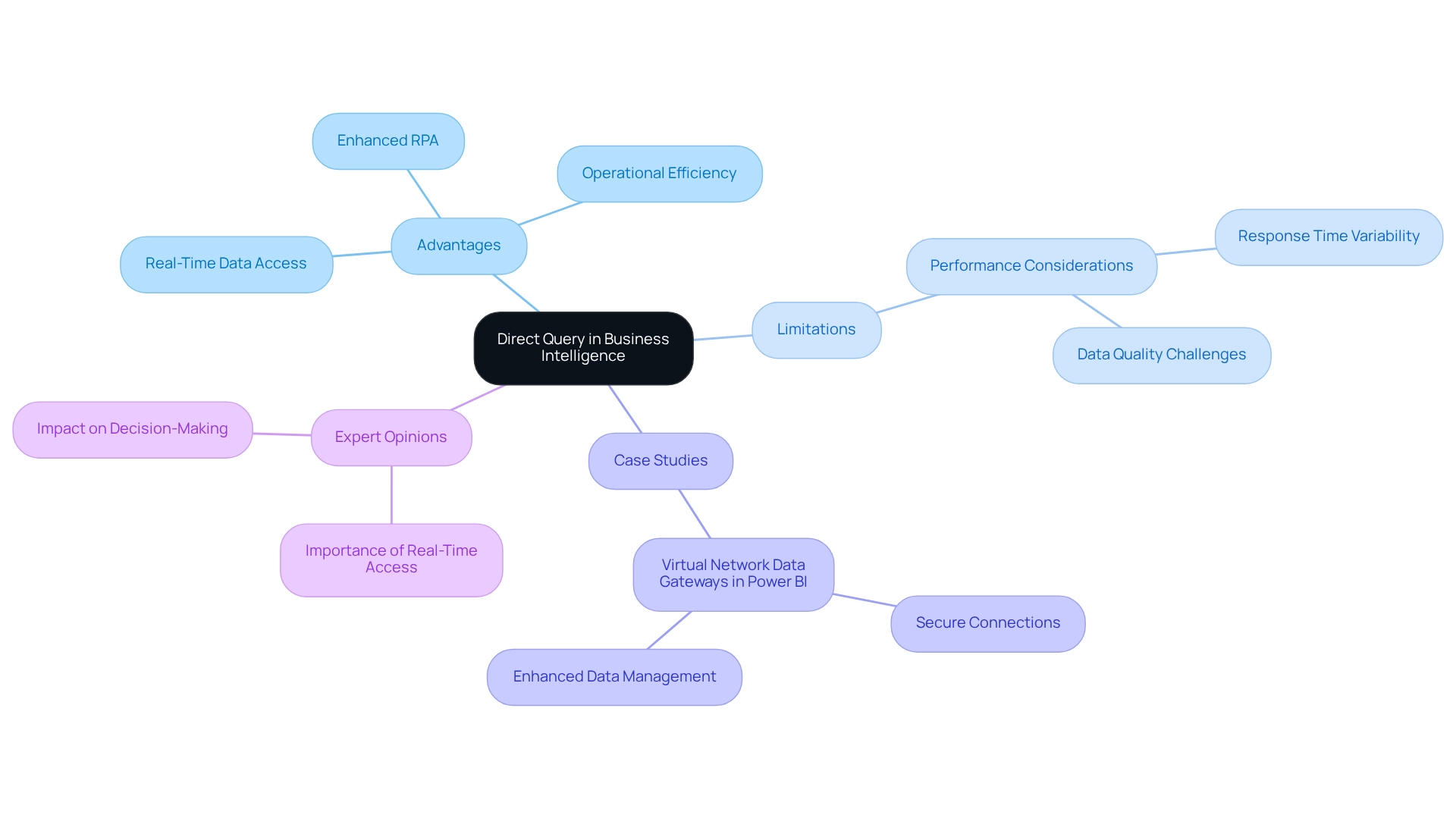
Key Benefits of Using Direct Query in Power BI
The primary benefits of utilizing Direct Query in Power BI are significant and multifaceted:
-
Real-Time Information Access: Direct Query allows users to access the most current information directly from the source, which is crucial for scenarios where timely insights are essential. This capability enables organizations to respond swiftly to changing conditions, enhancing operational agility. As Jeff Erickson, a Tech Content Strategist, observes, “Unlike conventional analytics, real-time analytics is about more than guiding future choices; it allows entirely new methods of conducting business by enabling teams to act instantly.” This is particularly relevant in the context of Business Intelligence, as the ability to derive actionable insights quickly can drive growth and innovation.
-
Reduced Information Storage Needs: By not storing information within Power BI, organizations can significantly lower their storage costs. This method streamlines information management and clarifies the concept of Direct Query by easing the difficulties linked with processing large collections, making it a cost-effective solution for many companies. Efficiency is further improved by RPA solutions that automate repetitive tasks, allowing teams to focus on strategic analysis rather than management.
-
Dynamic Reporting: With real-time access, users can create dynamic reports that automatically reflect alterations in the underlying information. This eliminates the need for manual dataset refreshes, ensuring that decision-makers always have access to the latest insights—vital for informed decision-making. The challenges of time-consuming report creation and inconsistencies are mitigated, allowing for a smoother analytical process.
-
Scalability: Direct Query is designed to handle extensive datasets that may exceed the memory thresholds of the BI tool. This scalability enables organizations to assess large volumes of information without encountering performance problems, making it an excellent option for information-heavy operations. The transformative impact of utilizing Direct Query in BI is emphasized by testimonials from clients like PALFINGER, who experienced significant acceleration in their BI development through Creatum’s BI Sprint service. This service not only provided them with a ready-to-use Power BI report but also enhanced their overall information analysis strategy.
The benefits of real-time information access are underscored by statistics showing that enhanced information accessibility can lead to a 20% improvement in overall research accuracy. Furthermore, organizations like Domino’s Pizza have demonstrated the power of real-time analytics; after implementing their ‘Domino’s Tracker’ system, they reported a 25% increase in customer satisfaction and sales. Such examples highlight Direct Query as a strategic resource that Immediate Inquiry signifies for companies seeking to optimize their data analysis capabilities and improve operational effectiveness.
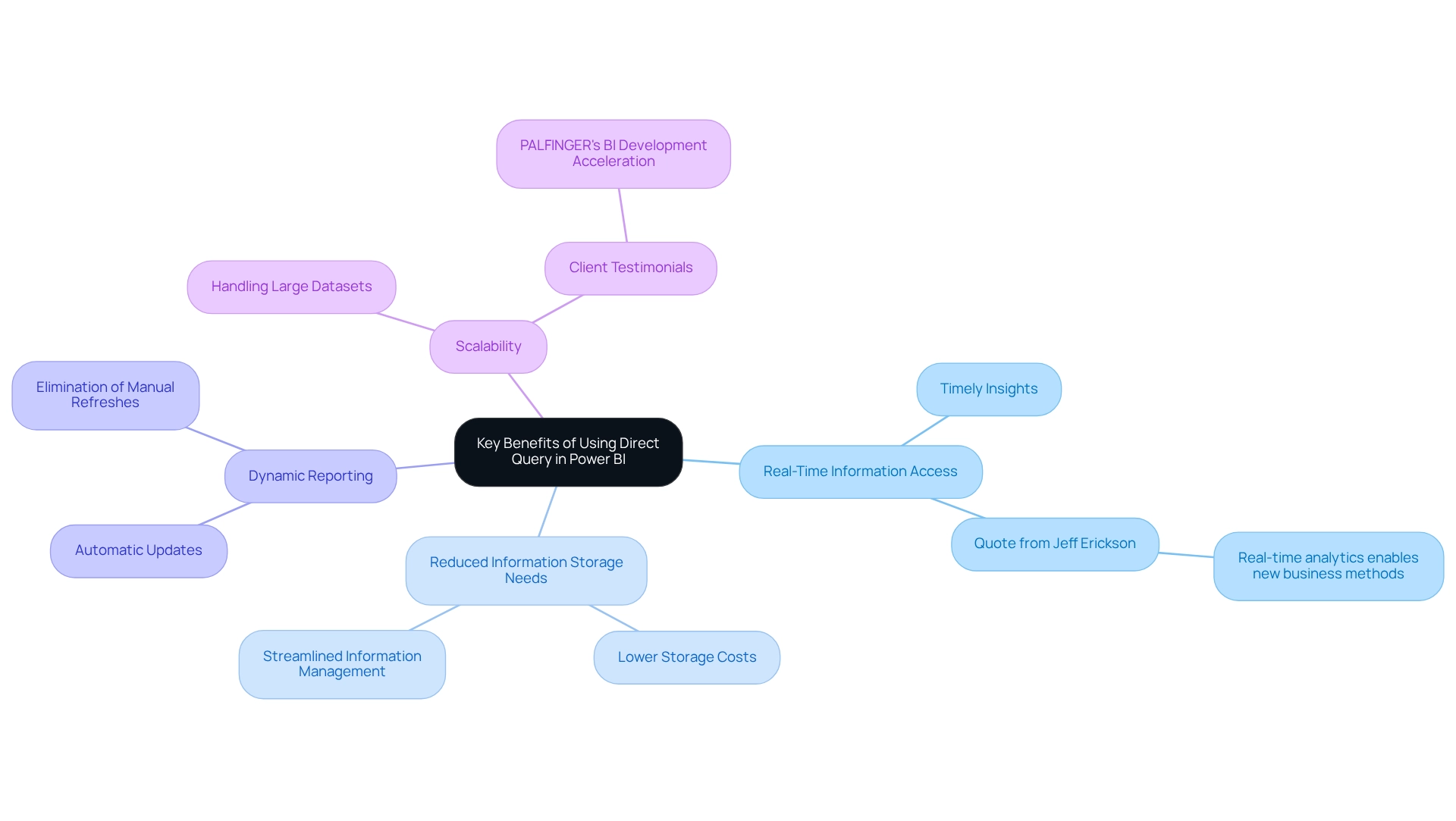
When to Use Direct Query: Ideal Scenarios
Immediate Inquiry proves to be especially beneficial in various critical situations:
-
For organizations grappling with large datasets that exceed Power BI’s import limits, understanding what direct query entails facilitates analysis without the constraints of memory limitations. Notably, a fixed limit of 1 million rows is placed on the number of rows that can be returned in any single query to the underlying source, as highlighted by v-jingzhang from Community Support. This capability is vital for sectors like healthcare and finance, where information volumes can be considerable. Utilizing Robotic Process Automation (RPA) can further enhance these processes, ensuring that information is efficiently managed and analyzed, thereby automating manual workflows that would otherwise consume valuable time.
-
Regularly Updated Information: Companies operating in dynamic environments, such as financial markets or inventory control, gain substantial advantages from real-time access to information. This feature allows for immediate insights, enabling timely decision-making that can significantly impact operational efficiency. By integrating RPA, organizations can automate the retrieval and processing of this information, enhancing responsiveness and reducing manual workload, which is essential for maintaining a competitive advantage.
-
Compliance and Security Mandates: Firms subject to strict information governance policies find Immediate Inquiry particularly advantageous. By retaining sensitive information in its original location, it mitigates the risk of breaches and ensures adherence to regulations, which is crucial for sectors like banking and healthcare. RPA can assist in monitoring compliance and automating reporting processes, further enhancing security measures and addressing technology implementation challenges.
-
Complex Information Models: In scenarios involving intricate information structures that require regular updates, Straightforward Access simplifies the querying process. Rather than relying on sporadic imports, it permits direct access to the information source, streamlining operations and improving accuracy. The integration of Business Intelligence tools can provide deeper insights into these complex models, driving better decision-making and overcoming the hurdles of technology implementation.
-
Statistics on Performance: Understanding what direct query is and how utilizing direct inquiries can significantly enhance query efficiency is essential, as serverless SQL pools optimize retrieval by bypassing unnecessary row groups based on specified conditions. This efficiency is vital for organizations that rely on large datasets for their analytics. RPA can help automate performance monitoring, ensuring that systems operate at peak efficiency and that manual oversight is minimized.
-
Case Studies: For instance, in addressing Azure Storage Throttling, organizations have implemented strategies to prevent overloading storage accounts during query execution. This method not only reduces throttling impacts but also sustains optimal request performance, demonstrating the practical advantages of immediate access in real-world applications. By merging RPA with immediate inquiries, companies can further boost their operational effectiveness and information management strategies, illustrating how automation can reduce manual effort and enhance overall performance.
By comprehending these situations, organizations can better utilize immediate inquiries in Business Intelligence to improve their analytics capabilities and foster informed decision-making. Additionally, the upcoming Microsoft Fabric Community Conference 2025, taking place from March 31 to April 2 in Las Vegas, Nevada, presents an opportunity for professionals to explore advancements in data analytics and network with industry leaders.
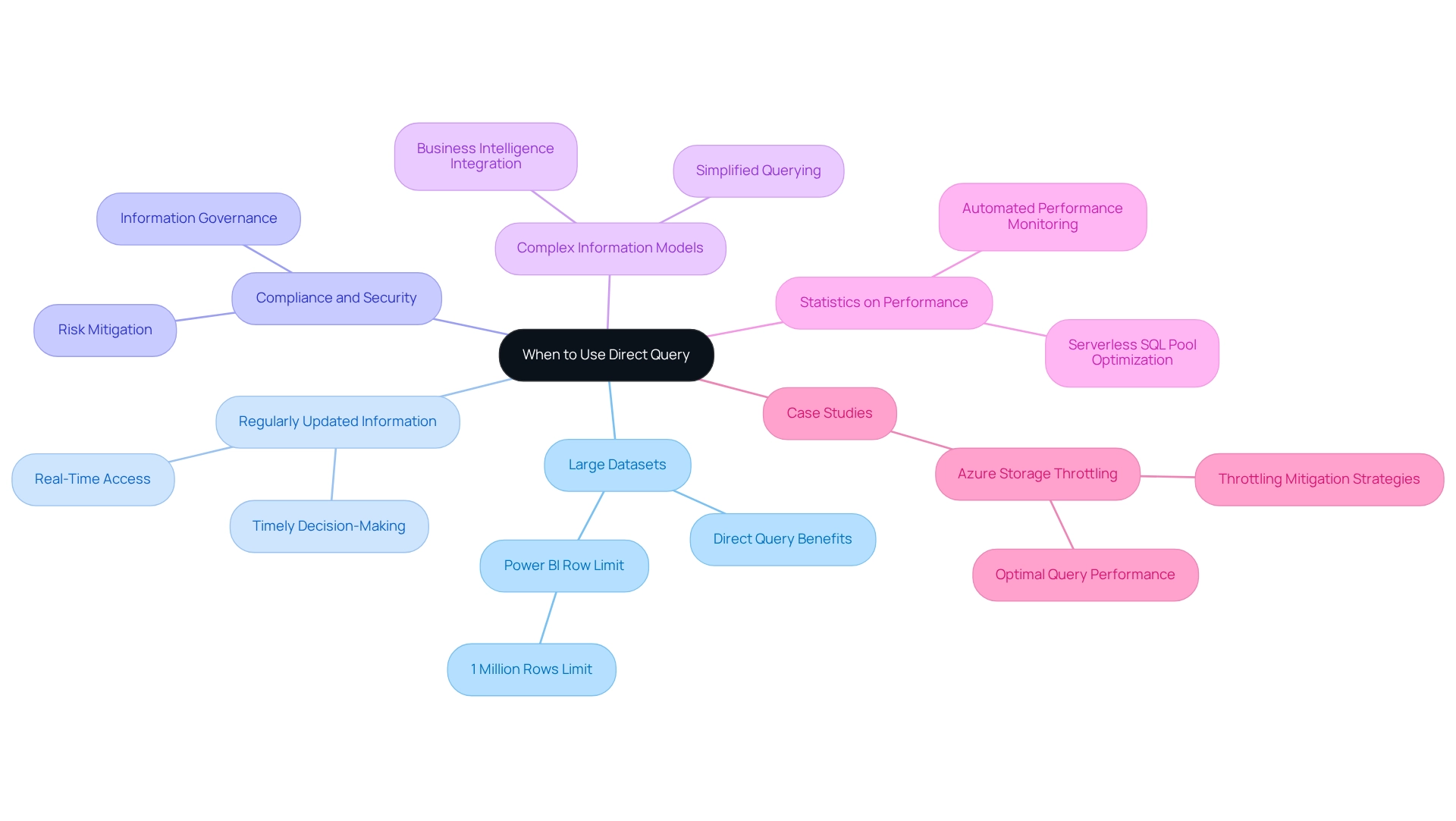
Challenges and Limitations of Direct Query
While Direct Query in Power BI offers notable advantages, it is crucial to acknowledge the accompanying challenges and limitations:
-
Performance Issues: A primary concern with Direct Query is its potential to slow down performance. This is particularly evident when the underlying information source is not optimized for efficient query execution. Each interaction with a report can initiate multiple inquiries to the source, leading to considerable delays in response times, especially during peak usage. The CALENDARAUTO DAX function, which scans all date and date/time columns in your model to determine the earliest and latest stored date values, can also impact performance if not managed properly. These performance challenges can hinder the effectiveness of business intelligence initiatives, making it essential for organizations to adopt solutions like RPA from Creatum GmbH to streamline workflows and enhance operational efficiency.
-
Restricted Information Transformations: When utilizing Immediate Inquiry, users face limitations in transformation capabilities within Power Transformation. Unlike imported information, which allows extensive manipulation, Immediate Access restricts the complexity of transformations that can be applied. This constraint can impede the ability to derive deeper insights from the information, underscoring the necessity for robust management practices to ensure high-quality master records.
-
Reliance on Source Performance: The effectiveness of immediate reports is closely tied to the performance of the underlying source. If the information source is slow or experiences downtime, it directly impacts the user experience in Power BI, potentially leading to frustration and decreased productivity. Organizations must address these challenges to leverage insights effectively and understand what Direct Query entails to make informed decisions.
-
Row Limitations: Direct Query imposes limits on the number of rows that can be retrieved in a single request. This limitation can significantly affect the analysis of large datasets, as users may find themselves unable to access all essential information for comprehensive reporting.
-
Common Performance Issues: Organizations frequently encounter performance challenges when using Direct Query. These include slow loading times, timeouts during information retrieval, and difficulties in managing large volumes of information. Such issues can undermine the effectiveness of business intelligence initiatives, particularly in understanding what Direct Query is. Optimization techniques such as removing unused columns, filtering information, and enabling incremental refresh can help alleviate these challenges, resulting in a more efficient and scalable Power BI model.
-
Expert Insights: Information management specialists emphasize that while Direct Query can facilitate real-time information access, it is vital to weigh these advantages against the potential performance limitations. CC Chen states, “In this article, I’ll be sharing my recent insights into analytical information processing — focusing on Business Intelligence dashboards and the…” This highlights the importance of balancing real-time access with performance factors, crucial for organizations striving to enhance their decision-making processes.
-
Case Studies: A significant case analysis on relationship dependencies illustrates how changes in one component can affect others, resulting in circular relationships that compromise information integrity. Understanding these dependencies is essential for managing the complexities associated with real-time data access, as they can greatly influence analysis and reporting.
-
Usage Metrics: It is important to note that usage metrics reports are not available in My Workspace, which may relate to the restrictions of immediate inquiry regarding accessibility and reporting.
In summary, while immediate access offers the promise of real-time data retrieval, organizations must navigate its limitations thoughtfully to ensure optimal performance and data integrity. By leveraging Business Intelligence and RPA solutions such as EMMA RPA and Automate from Creatum GmbH, businesses can address these challenges and foster growth through informed decision-making.
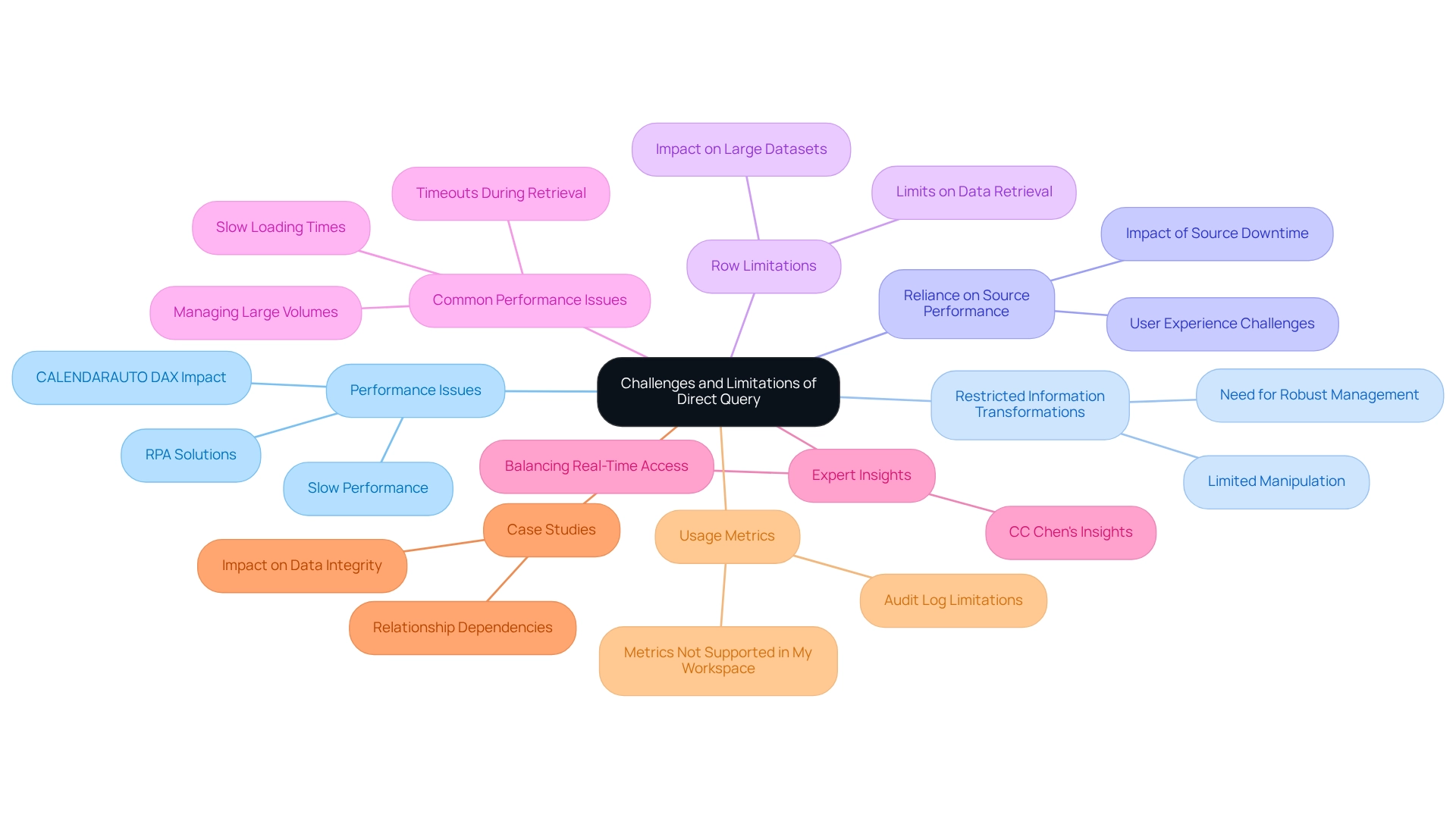
Performance Considerations for Direct Query
To enhance performance when utilizing Direct Query in Power BI, several key strategies should be implemented:
-
Optimize the Data Source: Ensure that the underlying database is meticulously optimized. This includes establishing proper indexing and conducting query performance tuning, which can significantly reduce response times and improve overall efficiency. This optimization is crucial to address the frequent issue of inconsistencies that can occur from poorly managed information sources. Furthermore, establishing a governance strategy can assist in preserving information integrity and consistency across reports.
-
Limit the Number of Queries: Utilize features like query reduction to decrease the frequency of requests sent to the source. This practice not only streamlines performance but also alleviates the load on the database, leading to faster report generation and allowing teams to focus on leveraging insights rather than spending excessive time on report creation. Robotic Process Automation (RPA) can also be utilized to automate repetitive tasks, further enhancing efficiency.
-
Utilize Aggregations: Applying aggregations within the information source can significantly decrease the amount of information being queried. This is especially advantageous for extensive datasets, as it improves performance by enabling the application to operate with summarized information instead of unprocessed material, thereby offering clearer, actionable insights.
-
Monitor Performance: Regularly evaluate the performance of real-time reports using tools like Power BI’s Performance Analyzer. This proactive monitoring aids in recognizing bottlenecks and areas for enhancement, ensuring that reports operate seamlessly and effectively, which is vital for preserving stakeholder confidence in the information presented.
-
Leverage Database Expertise: As highlighted in a case study explaining what is direct query implementation, having database expertise is crucial for optimizing performance. The case study outlines the challenges encountered when implementing DirectQuery, especially in environments with security restrictions that require on-premises information storage. It highlights the necessity for database proficiency to enhance performance and the challenges in attaining uniform information refresh across visuals. Achieving good performance with DirectQuery is complex and may require materializing calculated information in SQL, which could negatively impact user experience.
-
Focus on Measures for Analysis: Experts suggest depending on measures instead of implementing calculated information in SQL. As David Cenna, a certified expert in Data Import perspective, states, “Therefore, @Sam.McKay has always recommended to rely most of the times on measures in order to achieve diverse analysis.” This approach not only simplifies the analysis process but also enhances user experience by maintaining performance integrity.
-
Establish a Gateway for Refreshing Information: When publishing reports created with DirectQuery to the BI Service, it is essential to establish a Gateway for refreshing from on-premises information. This requirement is critical for ensuring that the reports remain up-to-date and perform optimally.
By implementing these approaches, organizations can greatly enhance the effectiveness of what is direct query in BI, resulting in more efficient information management and improved decision-making abilities. Moreover, incremental refresh verifies that only a few thousand new rows are retrieved daily, further highlighting the effectiveness of information management in immediate access.

Best Practices for Optimizing Direct Query Usage
To maximize the effectiveness of Direct Query in Power BI, consider these best practices:
-
Design Efficient Information Models: Focus on organizing your models to reduce complexity. Ensure that only essential information is queried. This approach streamlines performance and enhances user experience, aligning with the demand for tailored solutions in today’s AI landscape.
-
Utilize Query Caching: Take advantage of Power BI’s query caching capabilities to significantly boost performance. By storing results, you reduce the number of queries sent to the information source, resulting in quicker report loading times and enhanced responsiveness. This efficiency is vital for extracting significant insights from your data.
-
Implement Row-Level Security: Establish row-level security to manage access to information at a granular level. This practice ensures users only view data relevant to their roles, enhancing security and optimizing performance by limiting the data processed during queries, thereby supporting operational efficiency.
-
Regularly Review and Optimize Queries: Make it a routine to analyze your direct queries. Identifying and addressing inefficiencies can lead to substantial performance improvements, ensuring that your reports run smoothly and effectively. This is crucial for leveraging insights from Power BI dashboards.
-
Categorize Report Information by Business Impact: Use sensitivity labels to categorize report content based on its business impact. This strategy not only raises user awareness about information security but also aids in prioritizing access and management strategies, reinforcing the significance of BI in driving insight-driven decisions.
-
Learn from Real-World Examples: Reflect on the case study regarding Azure Storage Throttling, which underscores the importance of implementing strategies to avoid overloading the storage account during query execution. By doing so, organizations can mitigate throttling effects and enhance overall query performance, showcasing the practical outcomes of effective BI practices.
-
Integrate RPA Solutions: Consider incorporating Robotic Process Automation (RPA) to automate repetitive tasks related to information management and reporting. This integration can significantly enhance operational efficiency, allowing teams to focus on strategic decision-making instead of mundane tasks.
As Tim Radney remarked, “Thanks for this post; it was a good read,” emphasizing the value of sharing best practices within the community. By adhering to these best practices, organizations can improve their use of Direct Query in Business Intelligence, resulting in enhanced operational efficiency and more insightful analysis. Staying informed about best practices, as discussed in the author’s recent presentation at the PASS Community Summit, is essential for continued success in effectively utilizing BI.
Creatum GmbH is dedicated to assisting companies in overcoming these challenges and harnessing the full capabilities of their information.

Security Considerations in Direct Query
When utilizing Direct Query in Power BI, organizations must prioritize several critical security aspects to safeguard their data while effectively leveraging insights:
-
Information Access Control: Implementing strict access controls to the underlying information sources is crucial. This involves setting appropriate permissions for users accessing reports in Power BI, ensuring that only authorized personnel can view or manipulate sensitive information. Such practices not only protect information but also preserve the integrity of the insights obtained.
-
Encryption: Implementing encryption for information in transit is vital. This measure safeguards sensitive information from unauthorized access during query execution, thereby preserving the confidentiality and integrity of the information being processed. In an information-rich environment, the emphasis should be on actionable insights rather than merely raw data.
-
Audit Logging: Strong audit logging systems are essential for monitoring access and changes to the source. This practice provides a thorough account of who accessed which information and when, promoting accountability and transparency in information management. Such transparency is critical for building trust in the insights generated from Power BI dashboards.
-
Compliance with Regulations: Organizations must ensure that their use of Direct Query aligns with relevant information protection regulations, such as GDPR and HIPAA. Masha Komnenic, an Information Security and Data Privacy Specialist, emphasizes the importance of compliance, stating, “Implementing effective security measures is not just about protecting information; it’s about building trust with stakeholders through transparency and accountability.” Adhering to these regulations not only reduces legal risks but also enhances stakeholder trust by demonstrating a commitment to information privacy and security.
Considering the rising number of security incidents—114 publicly disclosed cases in October 2023 alone, compromising over 867 million records valued at over $5 billion—organizations must grasp the significance of Direct Query to adopt proactive measures that strengthen their security strategies. The North American information security market, valued at $34.58 billion in 2023, is anticipated to expand considerably, indicating an increased need for effective risk management solutions. This growth underscores the necessity for organizations to understand Direct Query in Business Intelligence, as it requires investment in robust access control measures and encryption practices to ensure their information remains secure and compliant, facilitating informed decision-making that fosters growth and innovation.
Moreover, organizations must recognize that inefficient utilization of Business Intelligence can lead to a competitive disadvantage, as time-consuming report generation and information inconsistencies obstruct the capacity to obtain actionable insights from Power BI dashboards. Creatum GmbH is committed to assisting organizations in navigating these challenges and enhancing their operational efficiency.
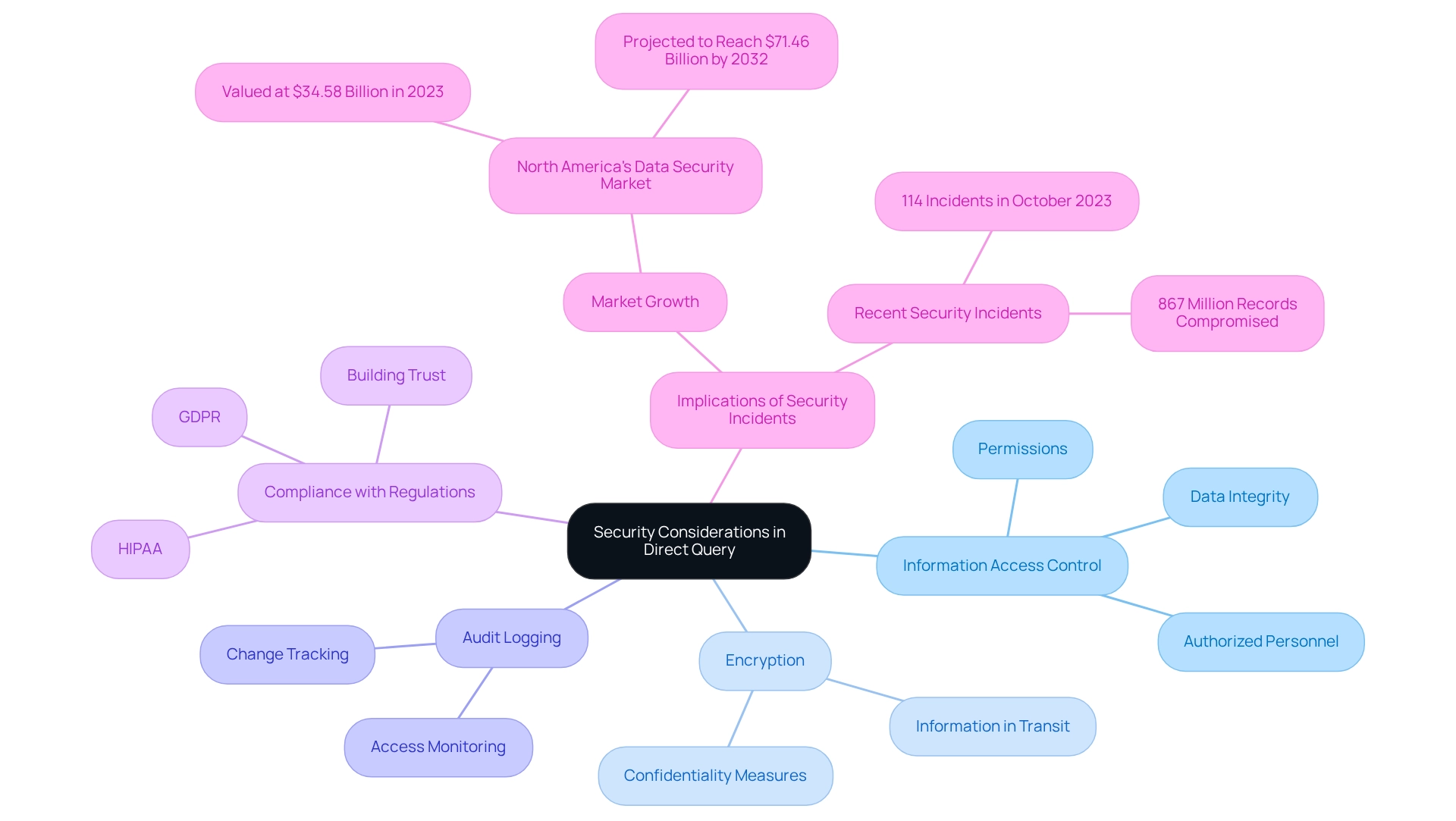
The Impact of Direct Query on Operational Efficiency
Direct Query can significantly enhance operational efficiency in various ways:
-
Streamlined Information Access: Direct query allows for real-time access to information, enabling quicker decision-making and significantly decreasing the time invested in information preparation. This immediacy empowers organizations to act swiftly on insights, which is crucial in today’s fast-paced business environment. By simplifying information access, organizations can propel growth and innovation, aligning with their mission to improve operational efficiency. A recent case study illustrated how a mid-sized healthcare firm faced obstacles like manual entry mistakes and sluggish software testing, but enhanced its operational workflows by adopting GUI automation, resulting in an 80% boost in efficiency.
-
Decreased Manual Efforts: By automating information retrieval, this method reduces the necessity for manual imports. This shift enables teams to focus on analysis instead of information management, resulting in significant time savings. Industry specialists have observed that organizations utilizing direct query can save up to 30% of the time they previously dedicated to information management. This efficiency is especially significant considering the environmental impact of information processing, as training one large language model can emit approximately 315 tons of carbon dioxide. In the case study, the healthcare company decreased entry mistakes by 70% through automation, demonstrating the effectiveness of such solutions.
-
Enhanced Collaboration: With current information readily available, teams can collaborate more effectively. This ensures that all stakeholders are working with the same information, fostering a unified approach to decision-making. Operations managers have indicated that streamlined data access, defined by direct query, has resulted in enhanced team alignment and quicker project completions. Testimonials from clients like NSB GROUP highlight how Creatum GmbH’s technology solutions have driven business growth through enhanced collaboration.
-
Improved Responsiveness: Organizations can respond more quickly to changing business conditions and market demands. By leveraging real-time insights, they can adapt strategies and operations promptly. For example, a recent case study emphasized how a pharmaceutical firm enhanced its operational flexibility by incorporating direct query, which enabled it to modify its supply chain strategies in reaction to market changes. This adaptability is essential, especially as pharmaceutical companies must implement quality checks and ensure explainability when integrating new technologies.
-
Impact on Operational Efficiency: The adoption of immediate data access has been demonstrated to improve operational efficiency considerably. Based on recent statistics, organizations using real-time data access have observed a 25% rise in overall efficiency metrics. This enhancement is credited to the decrease in latency and the capacity to make informed decisions quickly. As Michael Chui, a partner at McKinsey, stated, ‘The moment to take action is now,’ highlighting the urgency of embracing technologies such as direct query to enhance operational efficiency. The case study on GUI automation also reported a 50% acceleration in testing processes, further illustrating the benefits of automation.
-
Case Studies: An extensive examination of automation possibilities across 850 professions demonstrated that organizations utilizing immediate access not only improved their information retrieval but also optimized their overall operational processes. This research underscores the importance of adopting such technologies to stay competitive in the evolving landscape. The transformative effect of Creatum’s Power BI Sprint service has also been highlighted in client testimonials, demonstrating accelerated analytics and reporting success. Notably, the healthcare company achieved a return on investment (ROI) within six months of implementing these solutions.
In summary, understanding direct query not only streamlines data access and decision-making but also plays a pivotal role in driving operational efficiency, making it an essential tool for organizations aiming to thrive in 2025 and beyond.
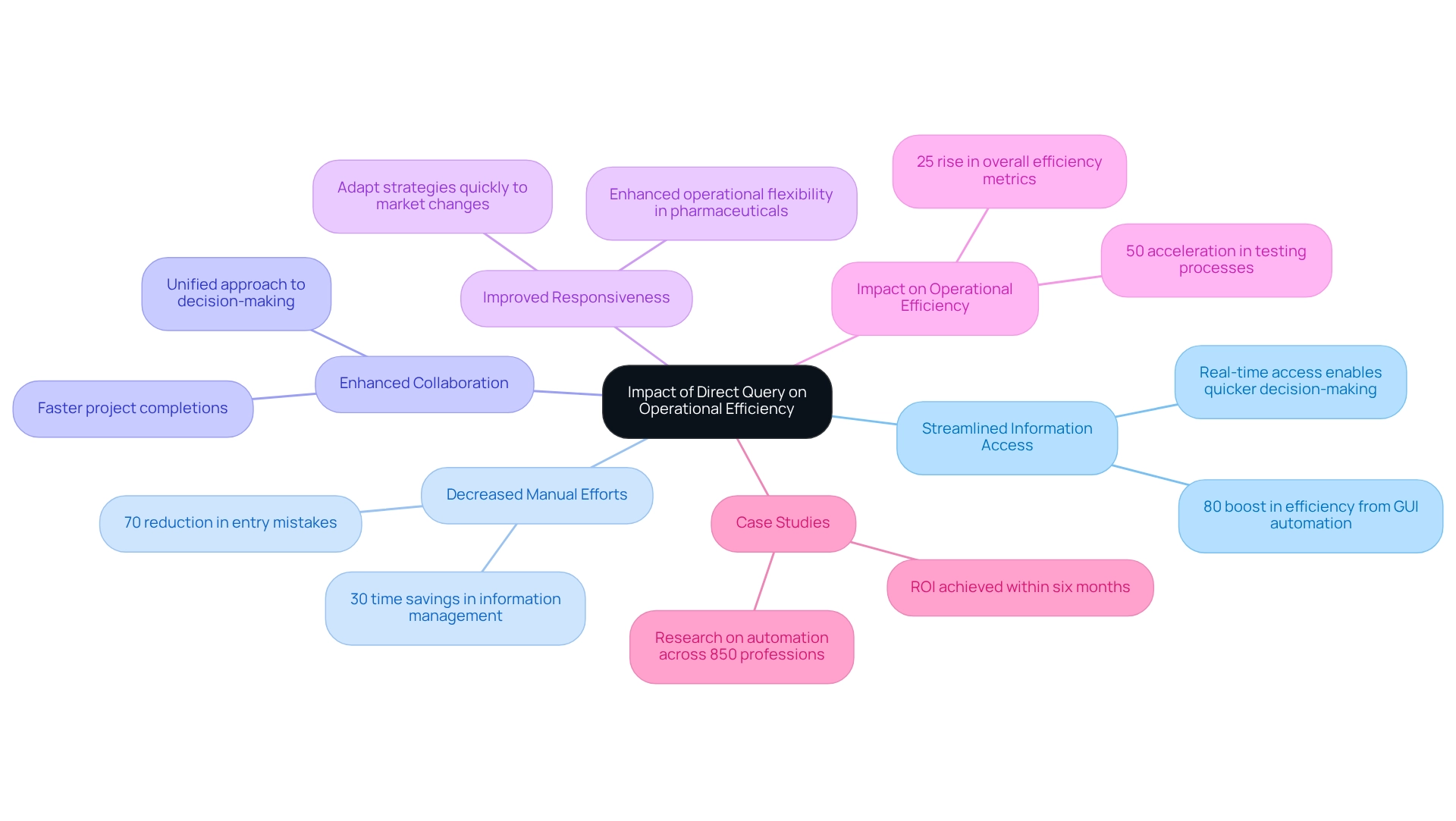
Conclusion
The implementation of Direct Query in Power BI stands out as a transformative solution for organizations aiming to elevate their data analytics capabilities. By providing real-time access to data, Direct Query empowers businesses to swiftly respond to market changes and operational demands, ultimately driving enhanced decision-making and operational efficiency. The capability to connect directly to data sources eliminates cumbersome data imports, streamlining reporting processes while reducing manual errors and freeing up valuable time for strategic analysis.
However, while the benefits of Direct Query are compelling, it is crucial to recognize and address the associated challenges, including performance issues and limitations on data transformations. Organizations must adopt best practices, such as:
- Optimizing data sources
- Implementing robust security measures
to fully harness the potential of Direct Query. By doing so, they can mitigate risks and ensure data integrity is maintained, fostering a more informed decision-making environment.
Ultimately, embracing Direct Query in Power BI positions organizations to thrive in an increasingly data-driven landscape. As they leverage real-time insights and automated processes, businesses can enhance collaboration, improve responsiveness, and achieve significant gains in operational efficiency. The journey to effective data utilization begins with a thorough understanding and implementation of Direct Query, paving the way for sustained growth and innovation in the years to come.
Frequently Asked Questions
What is Direct Query in Business Intelligence (BI)?
Direct Query is a connectivity mode in Business Intelligence that allows users to connect directly to data sources without importing data into BI’s internal storage, enabling real-time access to the most current information.
What are the advantages of using Direct Query?
The advantages of Direct Query include real-time information access, reduced information storage needs, dynamic reporting, and scalability for handling large datasets.
How does Direct Query enhance operational efficiency?
Direct Query eliminates the need for periodic data refreshes, allowing organizations to analyze real-time information, automate workflows through Robotic Process Automation (RPA), and reduce errors, ultimately enabling teams to focus on strategic tasks.
What are the performance considerations when using Direct Query?
The response time for queries can vary depending on the performance of the underlying data source and the complexity of the executed queries, which may affect overall performance.
How does Direct Query impact decision-making processes in organizations?
Organizations leveraging real-time retrieval through Direct Query can achieve faster decision-making processes, with some studies indicating a reduction in reporting times by up to 50% compared to traditional import methods.
What is the significance of real-time data access in business intelligence?
Real-time data access is critical for informed decision-making, particularly in fast-paced industries, as it allows companies to pivot quickly and capitalize on new opportunities.
What role does RPA play in conjunction with Direct Query?
RPA streamlines workflows and reduces errors, enhancing the effectiveness of Direct Query by allowing teams to focus on more strategic, value-adding tasks.
Can Direct Query handle large datasets effectively?
Yes, Direct Query is designed to manage extensive datasets that may exceed the memory thresholds of BI tools, making it suitable for information-heavy operations.
What are some real-world examples of organizations benefiting from Direct Query?
Companies like Domino’s Pizza have reported significant improvements in customer satisfaction and sales after implementing real-time analytics systems, demonstrating the strategic value of Direct Query in optimizing data analysis capabilities.
How does Direct Query ensure compliance and security?
The implementation of virtual network data gateways in Power BI enables secure connections to services within an Azure virtual network, enhancing data management capabilities while maintaining compliance and security.

